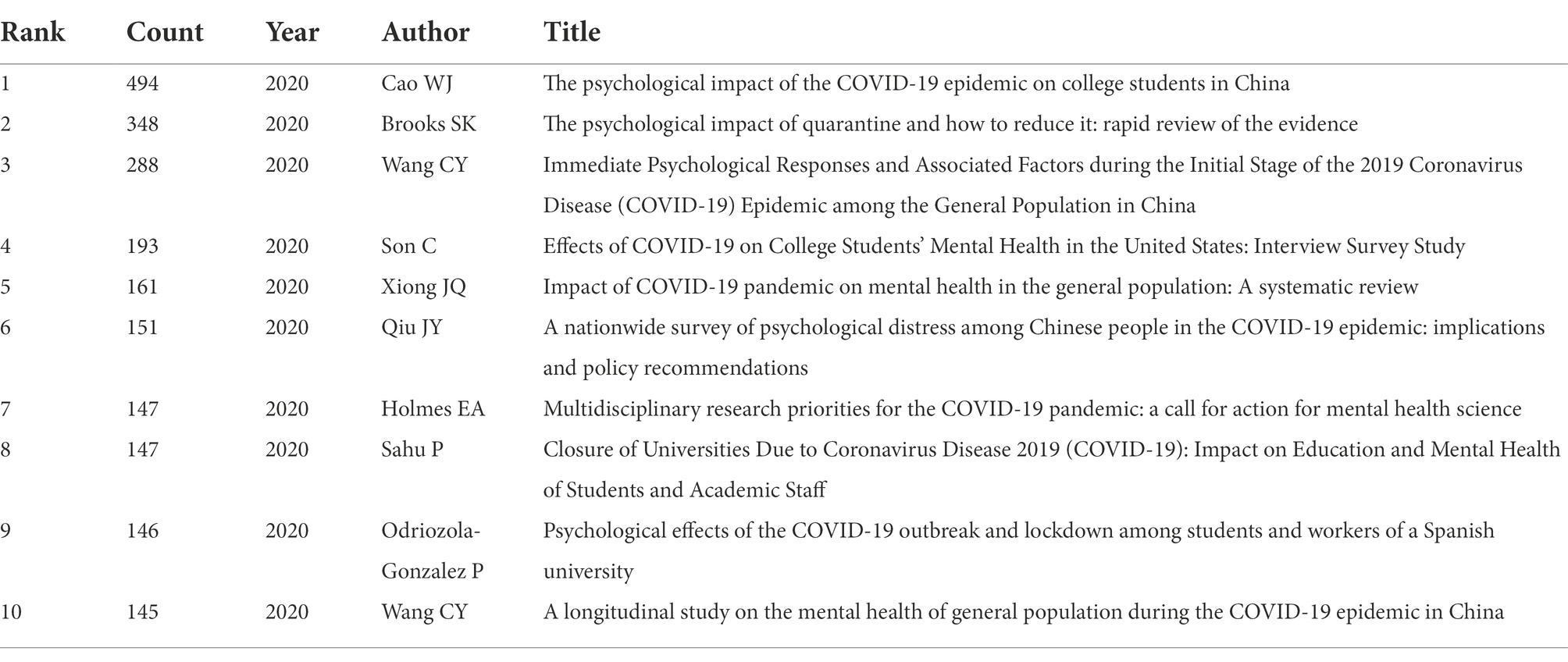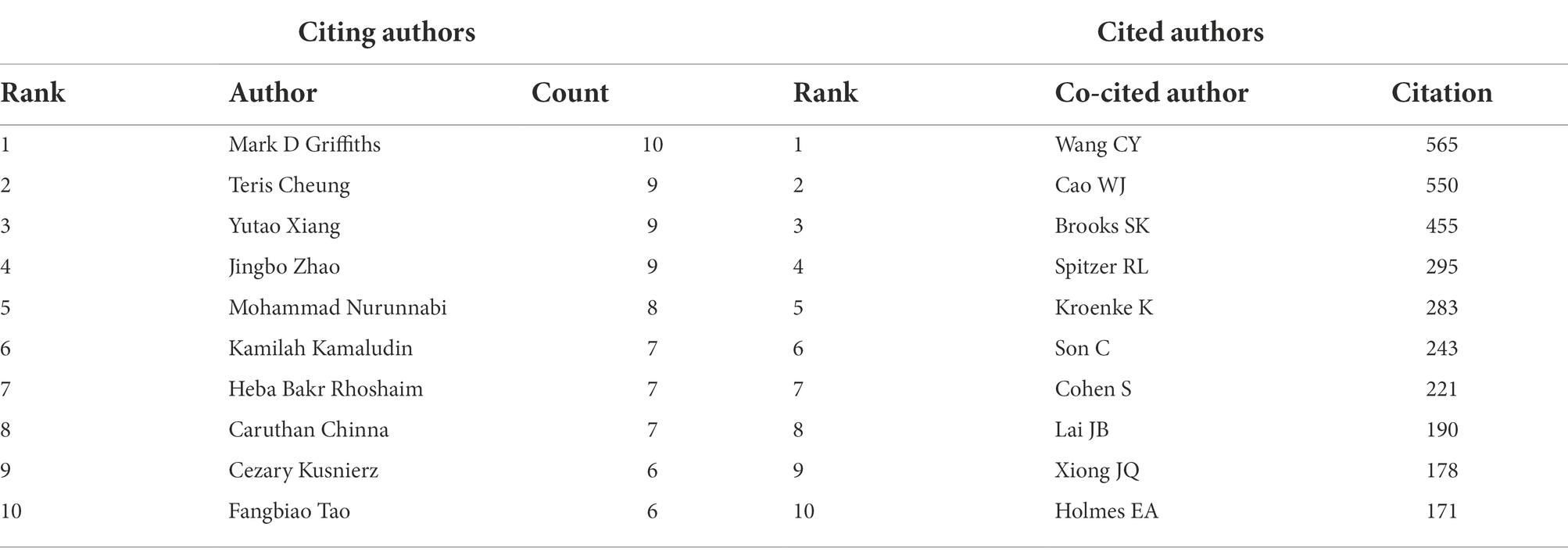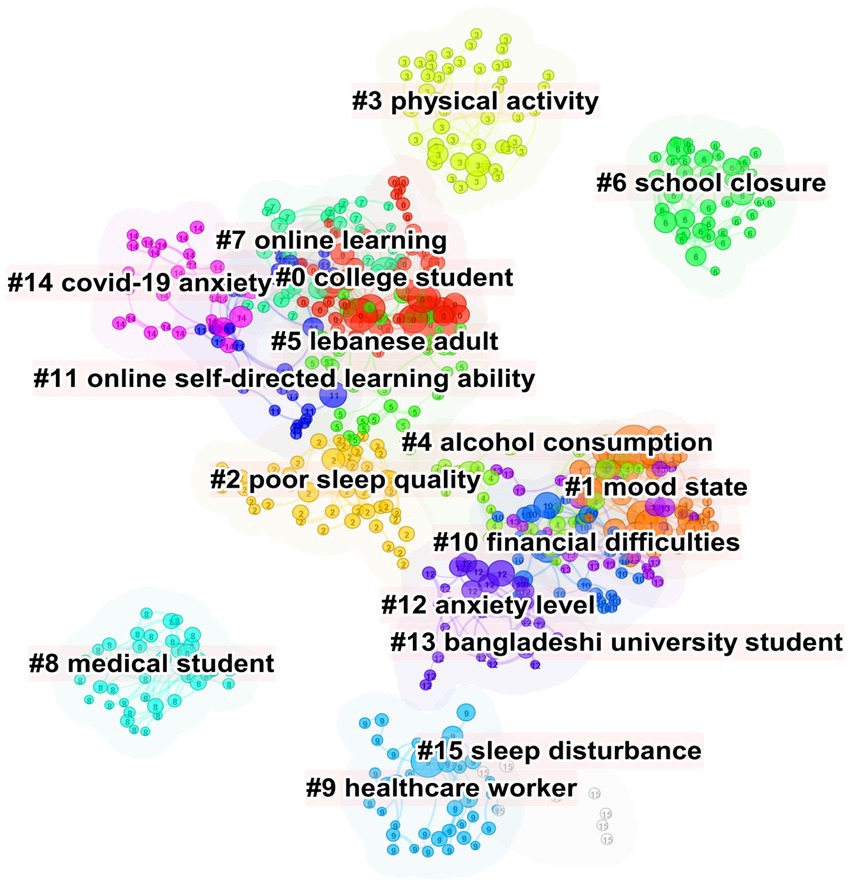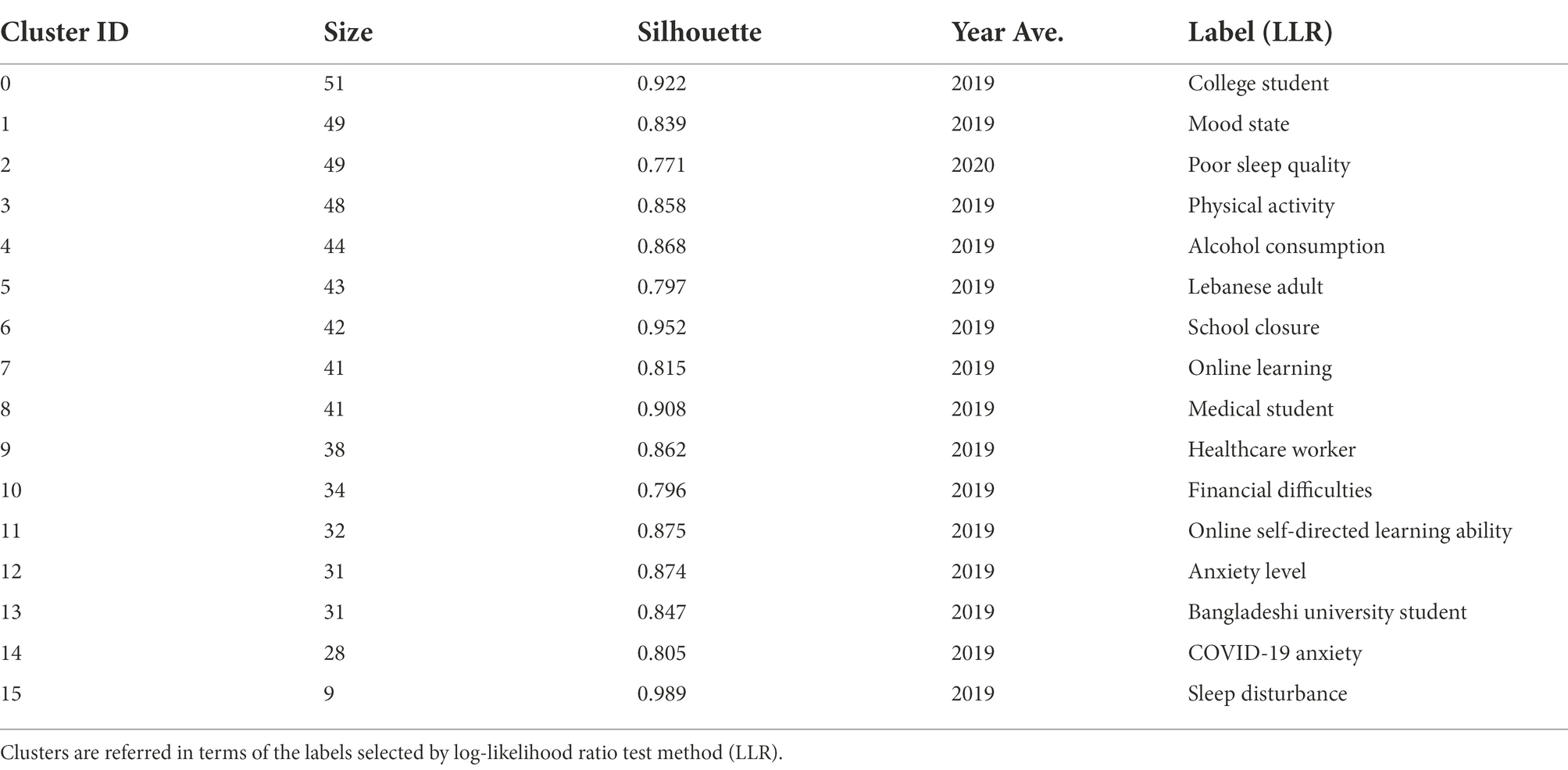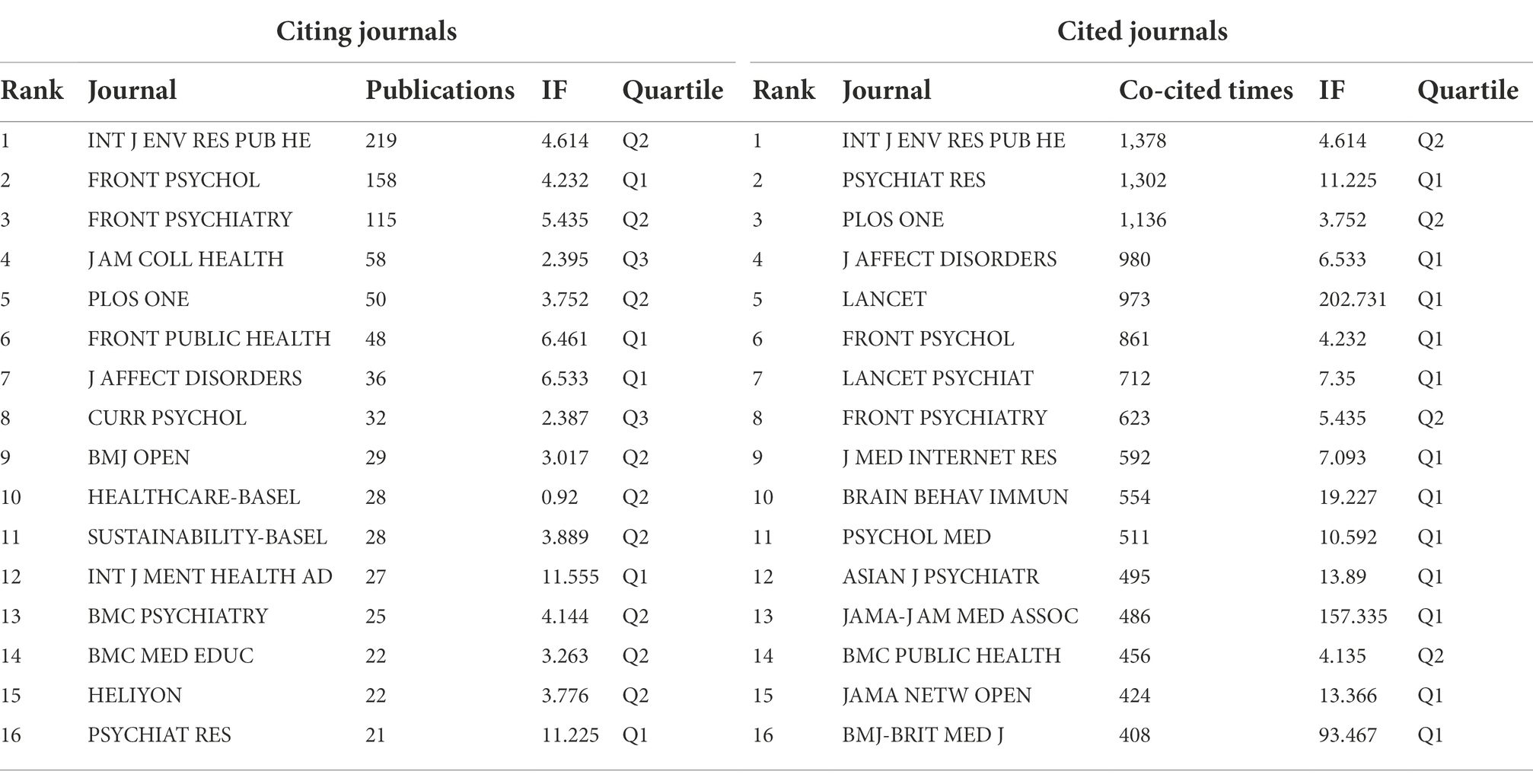- 1Department of Pediatrics, The 3rd Xiangya Hospital, Central South University, Changsha, Hunan, China
- 2Transplantation Center, The 3rd Xiangya Hospital, Central South University, Changsha, Hunan, China
- 3Department of Educational Affairs, The 3rd Xiangya Hospital, Central South University, Changsha, Hunan, China
- 4Research Center on Transplantation Medicine of National Health Ministry, Changsha, Hunan, China
Objective: The purpose of this study was to investigate the international scientific output on mental health of students during COVID-19 from 2020 to 2022 through a bibliometric analysis and to explore trend and research hotspots in this field.
Methods: We searched the Web of Science Core Collection for publications and used a variety of software to analyze and visualize the data such as R, CiteSpace, VOSviewer and Scimago.
Results: A total of 2,734 publications were retrieved as of June 4, 2022, published by 3,894 institutions from 120 countries/regions. China and the United States lead in the quantity and quality of publications in this field. According to Bradford’s Law, 16 journals are considered core journals in the field. Co-cited references indicate the main psychological problems of students under the epidemic revolve around anxiety, poor sleep and financial difficulty. Their behavior might also be influenced by increased internet and alcohol use.
Conclusion: Mental health of students during COVID-19 is attracting increasing attention. It is identified that the research hotspots in this field continue to revolve around emotional anxiety and unhealthy behaviors. Due to the different troubles faced by different groups under COVID-19, further exploration of the relevant factors specific for students are needed, with a hopeful view to providing ideas for intervention measures.
Introduction
The coronavirus disease 2019 (COVID-19) is an emerging epidemic caused by severe acute respiratory syndrome coronavirus 2 (SARS-CoV-2; Wang D. et al., 2020; Hu et al., 2021). Since 2019, the rapidly spreading COVID-19 pandemic has caused a global health threat (Fang et al., 2022). It is important to note that the COVID-19 pandemic is not only taking a toll on people’s physical health, but also has a negative impact on people’s mental health (Zhang and Chen, 2021; Pappa et al., 2022; Zhang et al., 2022).
As a vulnerable group, students are relatively more prone to negative psychological symptoms (Cao et al., 2020; Copeland et al., 2021). Numerous studies have shown that during the COVID-19 pandemic, students’ mental health has been severely challenged, regardless of their academic stage. A cross-sectional study using data from the Mental Health Survey of School-aged Children and Adolescents in Guangdong Province, China, showed that the prevalence of self-reported psychological distress among students was relatively high during the COVID-19 pandemic (Qin et al., 2021). A large-scale survey of 746,217 college students revealed that acute stress, anxiety, and depressive symptoms are prevalent during the COVID-19 pandemic, and that multiple epidemiological and psychosocial factors are associated with an increased risk of mental health problems (Ma et al., 2020). The mental health of master’s, doctoral and postdoctoral researchers has also been severely negatively impacted by the pandemic (Salim, 2021). This study aims to explore mental health-related conditions of students during the COVID-19 outbreak. We hypothesize that students’ mental health has been widely challenged during the COVID-19 pandemic and needs more care and support.
Over the past 2 years, a raft of research has been published on student mental health during the COVID-19 pandemic. However, there is no literature that systematically evaluates the relevant published literature. Bibliometrics uses mathematical and statistical methods to quantitatively analyze a large amount of literature in a specific research field, exploring research aspects and research trends in that field (Contreras-Barraza et al., 2021; Shen et al., 2022). Many researchers have used bibliometrics to evaluate their fields of study (Contreras-Barraza et al., 2021; Darroudi et al., 2021; Peng et al., 2022). However, no specific bibliometric studies have been conducted to date on the knowledge graph of student mental health during the COVID-19 pandemic. We have used bibliometrics to understand what is the current state of research work in this field, and question what are the research priorities and new trends? And further find out new problems that should addressed and possible directions to solve the problem. Therefore, we used R software, Scimago software, and citespace software to evaluate the literature on psychological stress of students during the COVID-19 period up to June 4, 2022 by bibliometric method, and generated knowledge maps. The results of these analyses can describe the current state of the field and identify new research directions.
Materials and methods
Literature retrieval
The literature retrieval was performed on June 4, 2022, using Web of Science Core Collection (WoSCC) to search for publications on research on psychological stress among students during COVID-19. The search terms we used were as follows: Topic: (COVID-19 OR SARS-CoV-2 OR 2019-nCov) and (mental health OR psychological stress) and (student OR pupil OR undergraduate OR freshman OR sophomore OR junior OR senior OR graduate OR master OR doctoral student). Among them articles and review articles were included in the study. All the records retrieved from the WoSCC were downloaded independently by two authors (QC and YY). A total of 2,734 documents published from 2020 to 2022 met the search criteria for this study.
Data collection and analysis
We exported a complete data record from WoSCC, including the number of annual publications, countries, journals, citations, impact factor (IF) and Hirsch index (H-index), etc. Firstly, the top 10 disciplines with annual publications were chosen to investigate the major study categories in this field. Accumulative publication, average citations per publication and H-index of top 10 countries with the most publications were analyzed to evaluate the scientific impact of the countries/regions. R version 4.0, a free software environment for statistical computing and graphics, was used to show the above results.
Cooperative networks between countries/regions and institutions were visualized by Scimage software. Co-cited author analysis was conducted, which was further clustered by CiteSpace. CiteSpace V software was used to conduct co-citation analysis of the references and further to group the references into 16 clusters. Next, a timeline view of co-cited references was constructed. The journals were also clustered by CiteSpace algorithm and the core journals were selected according to Bradford’s Law. CiteSpace could capture keywords with strong citation bursts and construct visualization maps of all items. A citation burst is a key indicator for identifying emerging trends (Chen et al., 2020). We used double image overlay to emphasize the key words of 2022 in CiteSpace. Conceptual analysis was performed using the R package “Bibliometrix”.1
Results
The overall trend of publications from 2020 to 2022
Information visualization was used to analyze articles on psychological stress among students during COVID-19 from WoSCC database from Jan 1, 2020 to June 4, 2022. The total number of cumulative publications in 2020, 2021, and 2022 was 439, 2,202, and 2,734, respectively (Figure 1A). The number of publications in 2021 was around four times than that of 2020, indicating that more attention in this field was obtained after the COVID-19 outbreak and high-quality articles erupted in 2020. Next, the co-cited reference analysis was carried out to explore which articles distinctively contributed to the development of this area. The most 10 co-cited articles were all published in 2020, the first three of which were authored by Cao WJ, Brooks SK and Wang CY, respectively (Table 1).
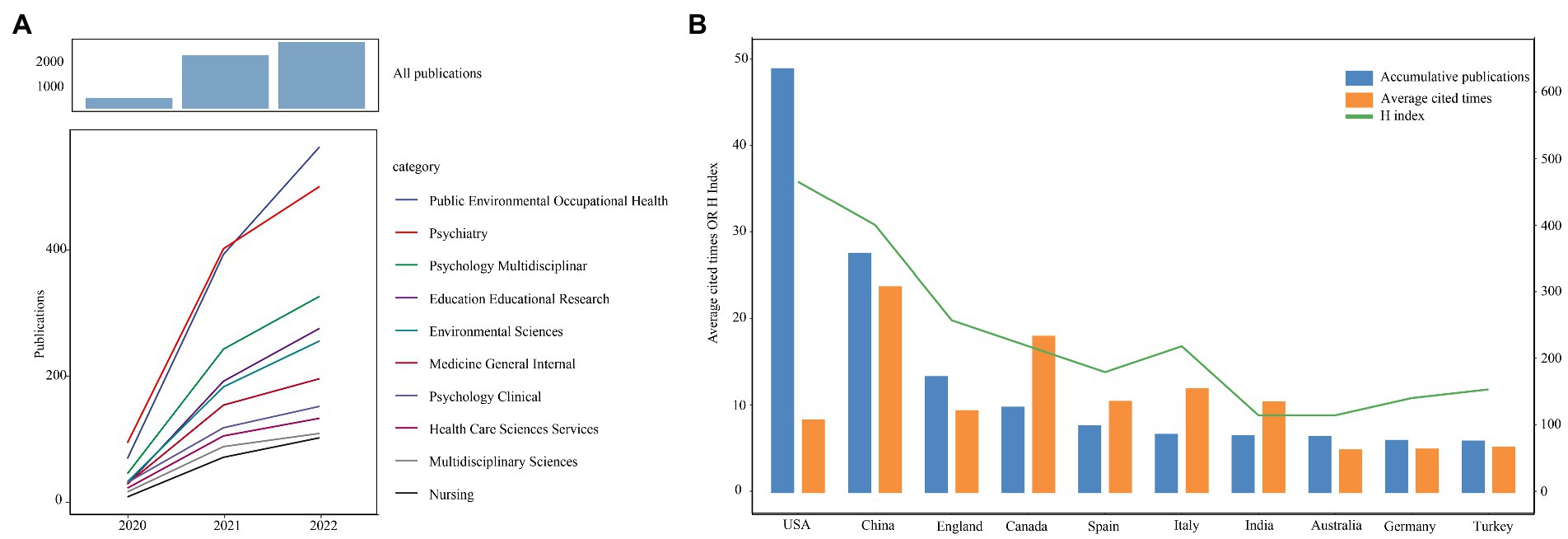
Figure 1. The overall distribution of publications. (A) The annual accumulative publications were exhibited by year and discipline. (B) The total number, average cited time and H-index of publications in countries.
The disciplines of this area were mainly about “psychology,” “environment” and “medicine.” The disciplines with the most publications are “public environmental occupational health” and “psychiatry,” the annual publication trend of which were consistent to the total publications (Figure 1A).
Country/region publication and collaboration analysis
All publications in the field were distributed among 3,894 institutions from 120 countries/regions, of which the production of the United States ranked the first with 749 documents by far, followed by China (445), the United Kingdom (216), Canada (156) and India (120) (Figure 1B, Table 2). The whole trend of H index was consistent with that of all publications where the United States (40), China (33) and the United Kingdom (21) ranked the first three. With reference to the average citations per articles, different from H index, China (20.82) and Canada (18.28) showed the highest average cited times while the United States (8.6) was relatively lower. Overall, the United States and China are the more enthusiastic and leading in research in this field.

Table 2. The top 10 productive countries/regions related to mental health in students under COVID-19.
Next, the inter-country collaborations and inter-agency partnership were investigated. Figure 2A presents the analysis of cooperation between countries. The countries/regions that cooperated closely were clustered together and given the same color. The thicker the line, the closer the cooperation between the two countries. The results showed that China and the United States had the closest cooperation in this area. The collaboration among the United States, Canada and the United Kingdom were also relatively closer, consistent to the publication trend. A network diagram showed partnerships between major institutions (Figure 2B). Circles represent institutions, and lines represent partnerships. The deeper the circle, the more papers the institution published in the field, and the thicker the line, the closer the cooperation between the two institutions. The strongest collaboration relationship was found between The University of Melbourne and Monash University.
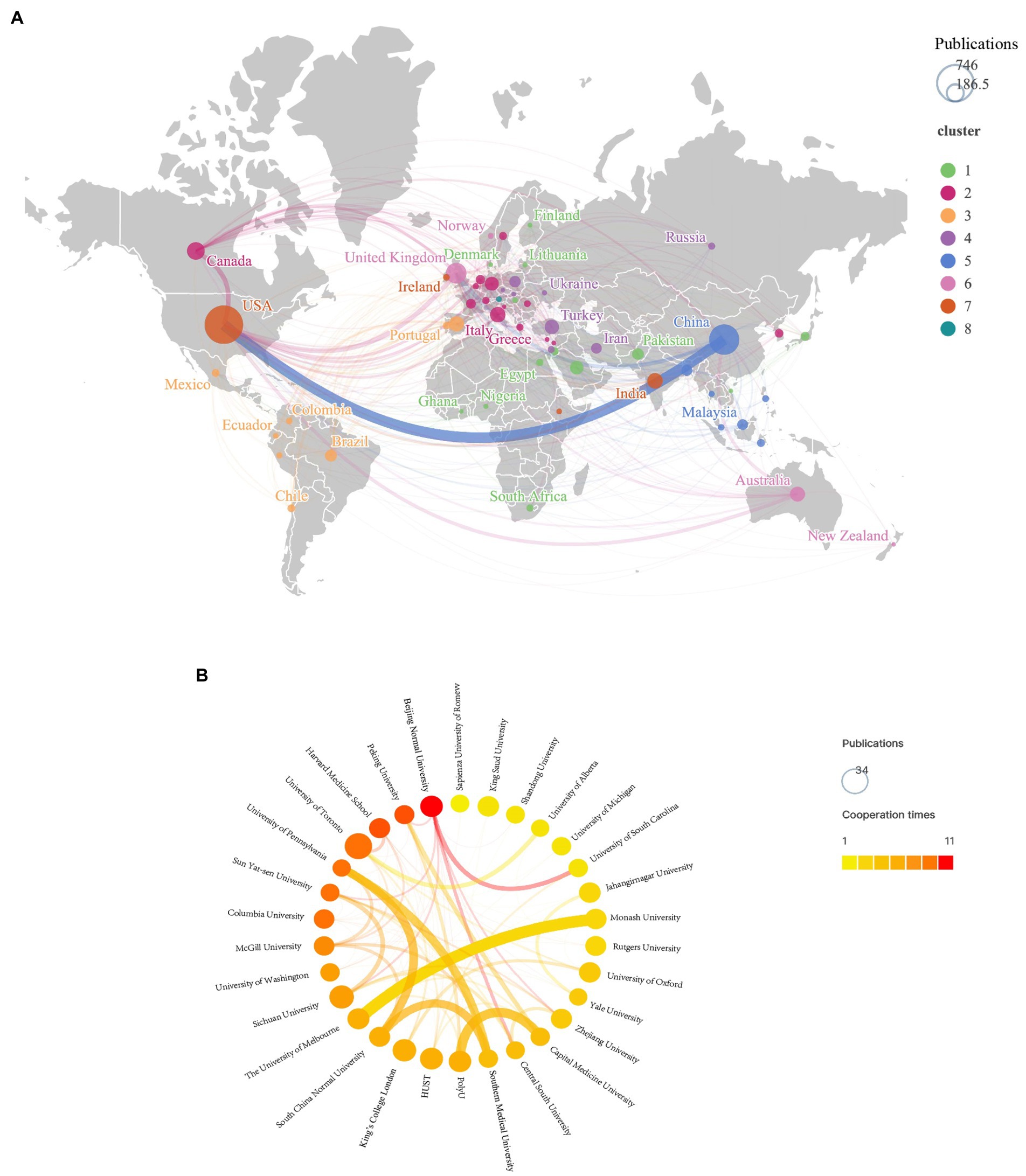
Figure 2. Collaboration visualization between countries/regions or institutions. (A) Collaboration analysis of countries/regions. (B) Collaboration analysis of instructions.
Co-cited author analysis
The selected 2,734 publications were produced by 12,889 authors and the top 10 productive authors and co-cited authors were listed in Table 3. Mark D Griffiths headed with 10 documents, followed closely by Teris Cheung, Yutao Xiang and Jingbo Zhao who all published 9 articles. The most frequently co-cited author was Wang CY with 565 co-cited times, followed by Cao WJ (550) and Brooks SK (455). These three authors were also the authors who wrote the most co-cited articles in this field (Table 1), revealing the significant effect of them. The author’s co-cited network analysis was visualized in Figure 3. Subsequently, we performed a cluster analysis of co-cited authors (Figure 3B). Most authors were clustered into “#0 Cross-sectional online survey study,” indicating the research in this field mainly focused on online questionnaires and cross-sectional surveys.
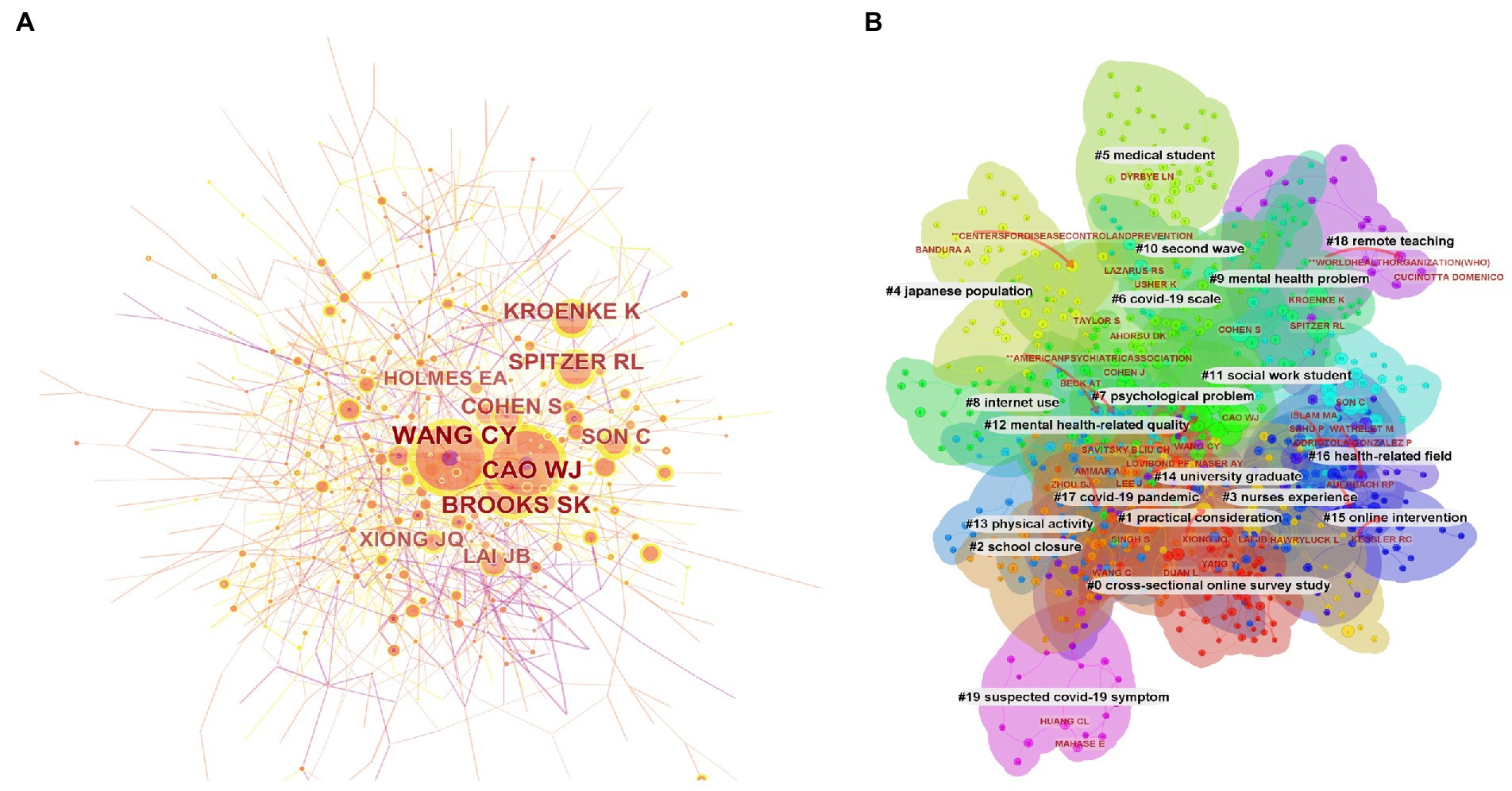
Figure 3. CiteSpace network visualization map of co-cited authors and their cluster results. (A) The co-cited author analysis. (B) Clusters of co-cited authors.
Reference co-citation analysis
A total of 41,321 co-cited references were visualized by CiteSpace with time slice set as a year (Figure 4). The references were clustered according to the log-likelihood ratio (LLR) algorithm, and 16 clusters were obtained (Figure 4, Table 4). The largest cluster is “college student” (cluster #0), followed by “mood state” (cluster #1), “poor sleep quality” (cluster #2), and “physical activity” (cluster #3). It is not surprising that college students were the most frequently studied group as it’s easier to collect their questionnaires. We further explored the cluster 1 and cluster 2, which both reflected the mental situation of students facing COVID-19. Tang WJ (89), Kaparounaki CK (80), Liu CH (62), Lei L (51) and Cellini N (39) were the most cited authors in “mood state,” and Husky MM (99), Auerbach RP (67), Zhang Y (66), Ammar A (45) and Stanton R (40) were the most cited authors in “poor sleep quality.” It was highly recommended to read these authors’ documents if related research needed to be conducted. Besides, “cluster 4: alcohol consumption,” “cluster 7: online learning” and “cluster 8: medical students” were of interest and the related authors were shown in Supplementary Table 1.
Afterwards, we constructed a timeline view of co-cited references to illustrate topic distribution in the field, and also investigated topic trends and interrelationships over time (Figure 5). In the timeline view, we found a sharp increase in the number of documents per cluster since 2019. It is apparent that this resulted from the outbreak of COVID-19.
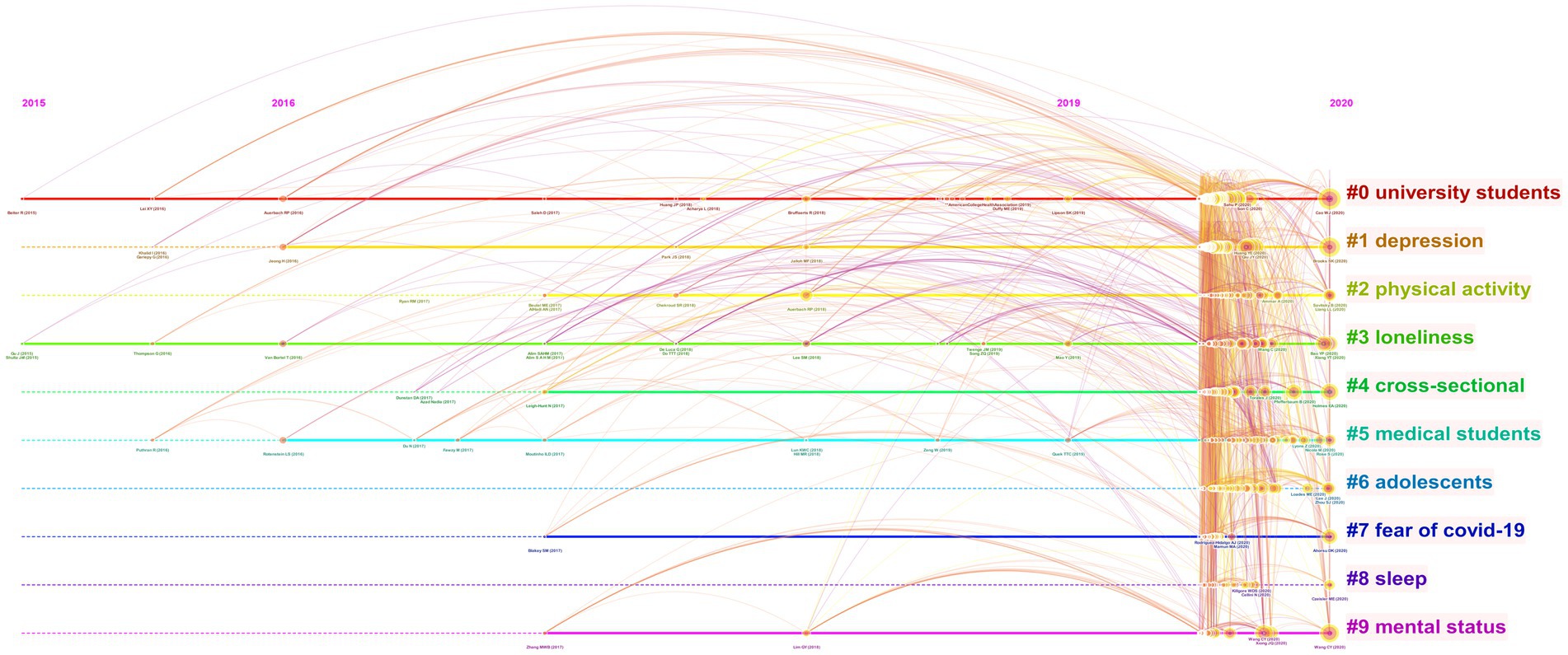
Figure 5. Timeline view of co-cited references related to mental health of students during COVID-19.
Journal analysis
In total, 927 journals have contributed to the 2,734 publications. According to Bradford’s Law, 16 journals were considered core journals in the field (Table 5), among which INT J ENV RES PUB HE contained the largest number of publications (219 publications), followed by FRONT PSYCHOL (158 publications) and FRONT PSYCHIATRY (115 publications). Concerning Impact Factor (IF), INT J MENT HEALTH AD has the highest IF (IF = 11.555) in 2019, followed by PSYCHIAT RES (IF = 11.225) and J AFFECT DISORDERS (IF = 6.533). In the quartile category, 5 of the 16 journals were in Q1 (the top 25% of the IF distribution) of different areas, 9 of 16 were in Q2 and the rest were in Q3.
The most co-cited journal was also INT J ENV RES PUB HE (1,378 citations), followed by PSYCHIAT RES (1,302 citations) and PLOS ONE (1,136 citations). 12 of the 16 co-cited journals were in Q1 and the rest were in Q2. These results showed that INT J ENV RES PUB HE, FRONT PSYCHOL and PLOS ONE had significant contributions in this field due to the higher publications and citations.
Keyword analysis
Citespace was used for keyword contribution analysis and keyword burst analysis from 2019 to 2022. Figure 6A shows the keyword contribution map from 2020 to 2022. Dual image overlay was used to investigate the keyword change trend in this field. The red line in Figure 6A represents the keyword contribution since 2022. No obvious change, however, was found. The main keywords were still about “mental health,” “anxiety,” and “stress.” Top 10 keywords with the strongest citation bursts were detected to provide helpful insights to research hotspots in this field (Figure 6B). All the bursts occurred in 2021 and lasted to 2022, some of which were overlapped with the clusters of co-cited references. Under the circumstance of COVID-19, the mental health issues post-traumatic stress disorder, anxiety and self-esteem might influence students. It was worth investigating how COVID-19 influenced students’ behavior on internet and alcohol use.
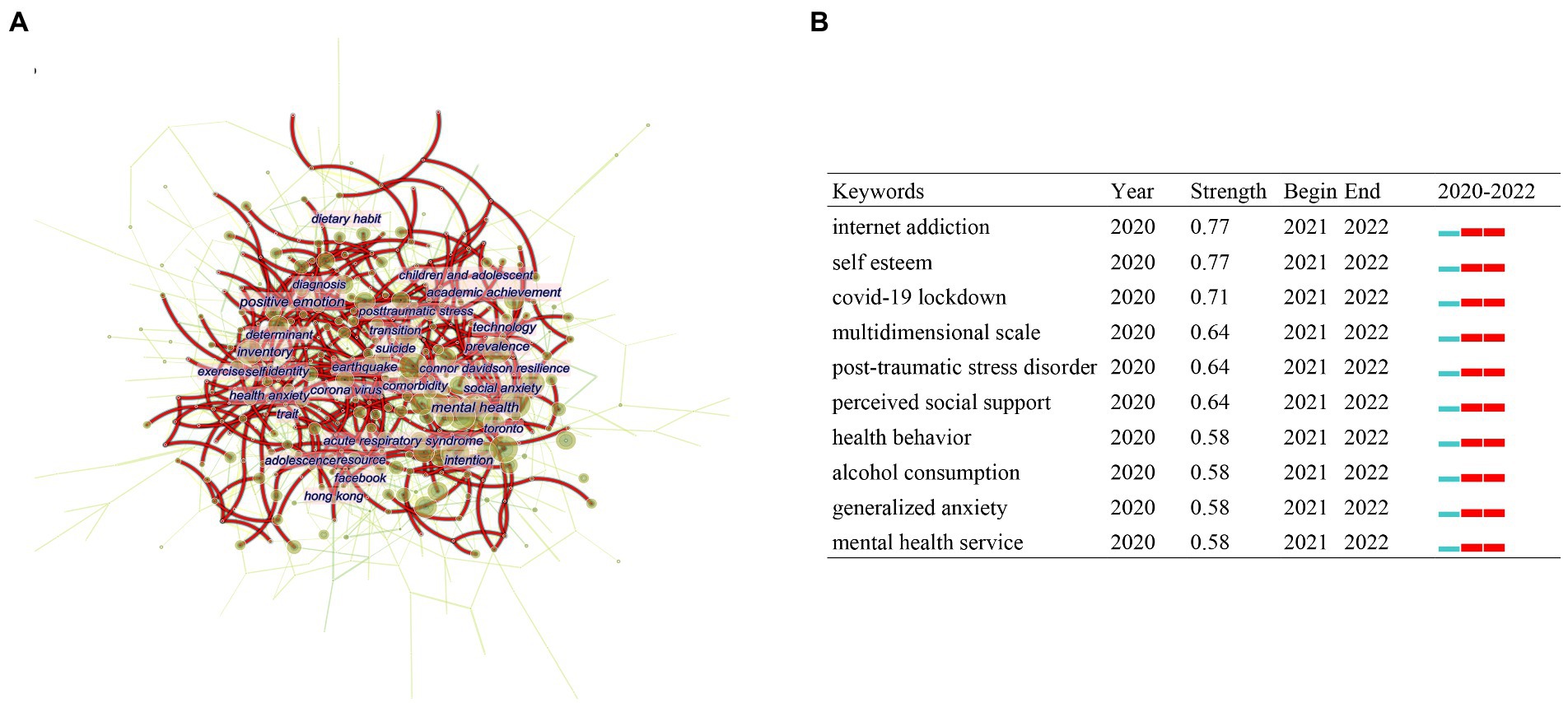
Figure 6. Keyword analysis of the research on mental health of students during COVID-19. (A) CiteSpace network visualization map of co-occurring keywords. (B) Top 10 burst keywords.
Conceptual structure analysis
The thematic map developed from the keywords was shown in Figure 7A, to examine the thematic concepts in the research field of students’ mental health during COVID-19, based on the typology of topics. No themes were found in the upper right quadrant. The basic themes in the lower right quadrant included “depression,” “stress” and “anxiety,” indicating the high centrality but low development degree. The upper left quadrant contained “health,” “students” and “life” with high development but low centrality, which was considered as niche themes. Themes such as “scale,” “validation” and “validity” were emerging or declining themes in the lower left quadrant, meaning the low centrality and low development degree. Moreover, there were also subjects located in the boundary between two quadrants. “Mental-health,” “impact” and “outbreak” were in the boundary between motor themes and niche themes, which had middle centrality and high development degree. Also, “adolescents,” “children” and “risk” were motor themes and basic themes simultaneously with high centrality and middle development degree.
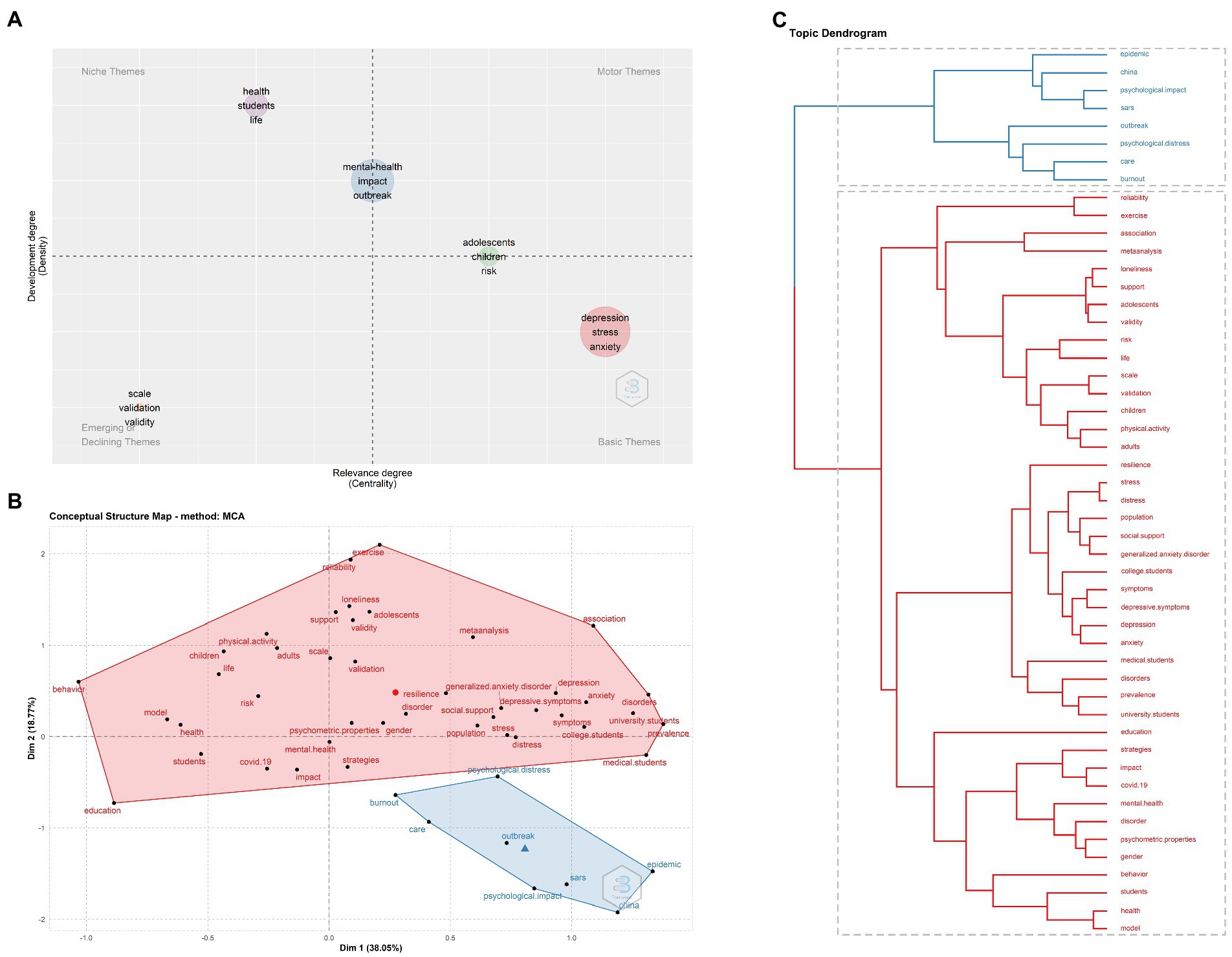
Figure 7. Conceptual analysis of mental health of students during COVID-19. (A) Thematic map of related research. (B) Word map of factorial analysis. (C) Topic dendrogram of factorial.
Multiple correspondence analysis (MCA) was used to construct a conceptual structure of this field. All keywords were classified into two clusters in blue and red (Figure 7B). Connection between the two clusters was shown in Figure 7C. The words in blue were mainly associated with COVID-19 and its influence such as “outbreak,” “epidemic” and “psychological impact.” The red cluster represented words related to the influenced population and specific emotions including “students,” “adolescents,” “university students,” “anxiety” and “depression.”
Discussion
Overall, this paper aims to investigate the output of international scientific publications on student mental health during the COVID-19 pandemic from 2020 to 2022 through a bibliometric analysis, and to explore research trends and hotspots in the field. We found that China and the United States lead in the quantity and quality of publications in this field. Importantly, 16 journals are considered core journals in the field according to Bradford’s Law. In addition, the co-cited references indicated that the main psychological problems of students under the epidemic were closely related to anxiety, poor sleep and financial difficulties. Their behavior may also be affected, such as increased internet usage and alcohol consumption.
In 2020, with the rapid spread of the COVID-19 pandemic, more and more countries have entered partial or nationwide lockdowns (To et al., 2021). Under this circumstance, the mental health of students during the COVID-19 pandemic received greater attention, and a total of 439 relevant publications were published. Between 2021 and 2022, the number of publications in this field increased dramatically. The cumulative number of related articles published in 2021 was 2,202, and in 2022, the number has risen to 2,734. This dramatic increase may be related to the growing physical, psychological, and social challenges that students faced during the pandemic. In terms of the number of relevant publications, the United States and China have the most publications in this field; China and Canada have the highest average citations; the United States and China have the highest H-index. From this perspective, China and the United States are leading the way in this research area. In addition, country/regional cooperation analysis also indicates that China and the United States have established close cooperation in this field. In the institutional collaboration analysis, the University of Toronto and Sichuan University have the most publications. In addition, Beijing Normal University, Peking University, and Harvard Medical School have the most cooperation occurrences, which shows that they are very active in inter-institutional collaborations in this field.
In the analysis of co-cited authors, Wang CY, Cao WJ, Brooks SK, Spitzer RL, Kroenke K, Son C, Cohen S, Lai JB, Xiong JQ and Holmes EA contributed the top 10 co-citations in turn. These researchers have made considerable contributions in this field.
According to the major clusters of co-cited references, we found that the hotspots of related research mainly focus on emotional status (mood state, anxiety level, COVID-19 anxiety), living habits (physical activity, alcohol consumption), learning status (school closure, online learning, online self-directed learning ability), sleep status (poor sleep quality, sleep disturbance), economic pressure (financial difficulties), and medical students (medical student, healthcare worker).
In Table 3, the most co-cited reference is “The psychological impact of the COVID-19 epidemic on college students in China” published by Cao WJ in 2020, and the co-citation count is 547. They conducted a sample analysis of college students at Changzhi Medical College and found that economic impact, daily life impact, and delay in academic activities were positively correlated with anxiety symptoms, while social support was negatively correlated with anxiety levels (Cao et al., 2020). At the same time, they made a recommendation for monitoring the mental health of college students during the COVID-19 pandemic. The second most co-cited reference was the review “The psychological impact of quarantine and how to reduce it: rapid review of the evidence.” Its authors, Brooks SK et al. published it in The Lancet in 2020. They examined the psychological effects of quarantine using three electronic databases. They examined the psychological effects of isolation using three electronic databases, most of which reported negative psychological effects (Brooks et al., 2020). Following these two papers is the article “Immediate Psychological Responses and Associated Factors during the Initial Stage of the 2019 Coronavirus Disease (COVID-19) Epidemic among the General Population in China” by Wang et al. Their findings suggest that females, students and people with specific physical symptoms are more likely to be associated with greater psychological impact and higher levels of stress, anxiety and depression (Wang C. et al., 2020). It is worth mentioning that the three authors, Cao WJ, Brooks SK and Wang CY, are also among the top three authors in the co-citation analysis of authors.
Research on student mental health during the COVID-19 pandemic has gained welcome interest from many journal editors. Among them, the 10 journals in Table 4 contributed the most. The top journals by number of publications are INT J ENV RES PUB HE, FRONT PSYCHOL, and FRONT PSYCHIATRY.
We performed keyword analysis and burst keyword analysis using CiteSpace. In the Keyword Contribution Graph, many keywords have made a large contribution, which shows that the research focus in this field is very diverse. In burst keyword analysis, the top 10 burst keywords in Figure 6 all appeared in 2021, and have maintained a high research interest in 2022. The keywords with the highest burst strength are internet addiction and self-esteem. Through a latent class analysis of Chinese schoolchildren, I-Hua Chen et al. found that during the recovery period of the COVID-19 outbreak, the two groups with a higher level of problematic internet use (PIU) had significantly higher levels of fear of COVID-19 than the one with a lower level (Chen et al., 2021). In addition, a study of residential college students during the COVID-19 lockdown found that the prevalence of PIU was high among residential college students during the COVID-19 lockdown, suggesting that the lockdown policy inevitably had an impact on their social lives. During such stressful events, they are vulnerable to PIU (Xia et al., 2021). Not only in China, many countries have reported the problem of internet addiction among students during the COVID-19 pandemic (Ismail et al., 2021; Kim et al., 2021; Shehata and Abdeldaim, 2021). This reminds us that we should pay attention to students’ Internet addiction during the COVID-19 pandemic. Numerous studies have shown that the negative impact of lockdowns caused by the COVID-19 pandemic on students with low self-esteem is significant. This means that schools and society should provide more support and attention to students with low self-esteem (Testoni et al., 2021; Vall-Roqué et al., 2021).
In addition to the research hotspots in this field, some neglected issues also need to be highlighted. First, suicide is the most serious consequence of negative mental health, but it has not been a research focus. Suicide and self-harm as a result of the direct and indirect effects of the COVID-19 pandemic is a major public health problem, and the social, psychological, and economic consequences of COVID-19 have the potential to impact global suicide rates (Farooq et al., 2021). The suicide rate of students has always been a serious problem, and the negative psychological state, financial burden and low self-esteem of students can lead to the increase of suicide rate (Toprak et al., 2011; Zhang et al., 2017; Duffy et al., 2019; Otsuka and Anamizu, 2019). Although there are relevant studies on the relationship between COVID-19 and student suicide rates and tendencies, this research direction should receive more attention (Hou et al., 2020; Fuse-Nagase et al., 2021; Marutani et al., 2021). Also, it is important to note that since suicides may be reported as unexpected events in statistics, this phenomenon may be underestimated (Pompili et al., 2012). Additionally, in addition to alcohol and Internet addiction, students’ marijuana, tobacco, and drug abuse issues during COVID-19 also require attention (Chaffee et al., 2021; Farhoudian et al., 2021).
From the results of this study, we found that the sources and influencing factors of students’ mental health problems during COVID-19 are extremely complex, which means that a single-approach solution may not be satisfactory. We need multidisciplinary support and multi-institutional collaboration. Such as the multidisciplinary consortium established by Odone et al. with expertise in the fields of economics, social sciences, epidemiology, public health and clinical medicine (Odone et al., 2020). Multidisciplinary competencies along with appropriate funding and access to rich data sources will go a long way toward achieving this goal. A holistic view of the physical, psychological, family and society is crucial to the search for solutions.
In addition, based on our results, it is also important to focus on specific groups of students, including students with addictive habits, students suffering from illness, and students with financial difficulties. It is reasonable to assume that the COVID-19 pandemic exacerbated the plight of these students and significantly damage their mental health. In terms of addictive behaviors, numerous articles have demonstrated the strong relationship between social media addiction, alcohol addiction, drug addiction, smartphone addiction, and other addictive behaviors with COVID-19 and mental health (Sujarwoto et al., 2021; Hu et al., 2022; Lardier et al., 2022; Yehudai et al., 2022). In 2020, a study focusing on children with attention deficit hyperactivity disorder (ADHD) during the COVID-19 pandemic demonstrated that the COVID-19 pandemic further exacerbated these children’s mental health and worsened their behavioral problems (Zhang et al., 2020). There are not many similar studies, but research into the psychological profile of students with disease burden may be a future research trend in this field. There have been many reports on the financial stress of students (Jones et al., 2021; Myhr et al., 2021). However, due to the various factors that cause personal economic stress, such as family, society, region, economy, etc., this direction is still worthy of further research.
Our study has two major limitations. First, we only searched literature data on WoSCC and included only English literature, which may lead to selection bias. Second, authors with the same name and the diversity of keyword expressions can lead to bias.
Conclusion
Since the COVID-19 pandemic, the number of publications related to student mental health has increased dramatically. China and the United States lead in the quantity and quality of publications in this field. This article is the first bibliometric analysis based on the mental health of students during COVID-19 to study the research trends and hot spots. From the detected clusters of citations, students may continue to face difficulties with financial burden, anxiety and poor sleep. Student mental health may be influenced by other factors such as internet and alcohol dependence, which requires further exploration. With the assistance of information visualization, we identified the research hotspots in this field continue to revolve around emotional anxiety and unhealthy behaviors. Further study is needed to investigate the relationship of mental issue and various stressors and the interventions that effectively regulate psychological stress.
Data availability statement
The original contributions presented in the study are included in the article/Supplementary material, further inquiries can be directed to the corresponding authors.
Author contributions
QZ and MZ designed this study. QZ, MZ, YY, and QC reviewed and revised the manuscript. QC drafted the original manuscript. YY collected data, performed preliminary data analysis, and completed figures and tables. All authors approved the final manuscript submission and agreed to be responsible for all aspects of the work.
Funding
This study was supported by grants from the National Natural Science Foundation of China (81700658 and 82270795) and the Hunan Provincial Natural Science Foundation (2020JJ3058 and 2020JJ4864).
Conflict of interest
The authors declare that the research was conducted in the absence of any commercial or financial relationships that could be construed as a potential conflict of interest.
Publisher’s note
All claims expressed in this article are solely those of the authors and do not necessarily represent those of their affiliated organizations, or those of the publisher, the editors and the reviewers. Any product that may be evaluated in this article, or claim that may be made by its manufacturer, is not guaranteed or endorsed by the publisher.
Supplementary material
The Supplementary material for this article can be found online at: https://www.frontiersin.org/articles/10.3389/fpsyg.2022.985866/full#supplementary-material
Footnotes
References
Brooks, S. K., Webster, R. K., Smith, L. E., Woodland, L., Wessely, S., Greenberg, N., et al. (2020). The psychological impact of quarantine and how to reduce it: rapid review of the evidence. Lancet 395, 912–920. doi: 10.1016/S0140-6736(20)30460-8
Cao, W., Fang, Z., Hou, G., Han, M., Xu, X., Dong, J., et al. (2020). The psychological impact of the COVID-19 epidemic on college students in China. Psychiatry Res. 287:112934. doi: 10.1016/j.psychres.2020.112934
Chaffee, B. W., Cheng, J., Couch, E. T., Hoeft, K. S., and Halpern-Felsher, B. (2021). Adolescents’ substance use and physical activity before and during the COVID-19 pandemic. JAMA Pediatr. 175, 715–722. doi: 10.1001/jamapediatrics.2021.0541
Chen, I. H., Chen, C.-Y., Liu, C.-H., Ahorsu, D. K., Griffiths, M. D., Chen, Y.-P., et al. (2021). Internet addiction and psychological distress among Chinese schoolchildren before and during the COVID-19 outbreak: a latent class analysis. J. Behav. Addict. 10, 731–746. doi: 10.1556/2006.2021.00052
Chen, L., Ma, S., Hu, D., Lin, H., Zhu, Y., Chen, K., et al. (2020). Bibliometric study of sodium glucose cotransporter 2 inhibitors in cardiovascular research. Front. Pharmacol. 11:561494. doi: 10.3389/fphar.2020.561494
Contreras-Barraza, N., Madrid-Casaca, H., Salazar-Sepúlveda, G., Garcia-Gordillo, M. Á., Adsuar, J. C., and Vega-Muñoz, A. (2021). Bibliometric analysis of studies on coffee/caffeine and sport. Nutrients 13:3234. doi: 10.3390/nu13093234
Copeland, W. E., McGinnis, E., Bai, Y., Adams, Z., Nardone, H., Devadanam, V., et al. (2021). Impact of COVID-19 pandemic on college student mental health and wellness. J. Am. Acad. Child Adolesc. Psychiatry 60, 134–141. doi: 10.1016/j.jaac.2020.08.466
Darroudi, M., Gholami, M., Rezayi, M., and Khazaei, M. (2021). An overview and bibliometric analysis on the colorectal cancer therapy by magnetic functionalized nanoparticles for the responsive and targeted drug delivery. J. Nanobiotechnol. 19:399. doi: 10.1186/s12951-021-01150-6
Duffy, M. E., Twenge, J. M., and Joiner, T. E. (2019). Trends in mood and anxiety symptoms and suicide-related outcomes among U.S. undergraduates, 2007-2018: evidence from two National Surveys. J. Adolesc. Health 65, 590–598. doi: 10.1016/j.jadohealth.2019.04.033
Fang, E., Liu, X., Li, M., Zhang, Z., Song, L., Zhu, B., et al. (2022). Advances in COVID-19 mRNA vaccine development. Signal Transduct. Target. Ther. 7:94. doi: 10.1038/s41392-022-00950-y
Farhoudian, A., Radfar, S. R., Mohaddes Ardabili, H., Rafei, P., Ebrahimi, M., Khojasteh Zonoozi, A., et al. (2021). A global survey on changes in the supply, Price, and use of illicit drugs and alcohol, and related complications during the 2020 COVID-19 pandemic. Front. Psych. 12:646206. doi: 10.3389/fpsyt.2021.646206
Farooq, S., Tunmore, J., Wajid Ali, M., and Ayub, M. (2021). Suicide, self-harm and suicidal ideation during COVID-19: a systematic review. Psychiatry Res. 306:114228. doi: 10.1016/j.psychres.2021.114228
Fuse-Nagase, Y., Marutani, T., Tachikawa, H., Iwami, T., Yamamoto, Y., Moriyama, T., et al. (2021). Increase in suicide rates among undergraduate students in Japanese national universities during the COVID-19 pandemic. Psychiatry Clin. Neurosci. 75, 351–352. doi: 10.1111/pcn.13293
Hou, T.-Y., Mao, X.-F., Dong, W., Cai, W.-P., and Deng, G.-H. (2020). Prevalence of and factors associated with mental health problems and suicidality among senior high school students in rural China during the COVID-19 outbreak. Asian J. Psychiatr. 54:102305. doi: 10.1016/j.ajp.2020.102305
Hu, B., Guo, H., Zhou, P., and Shi, Z.-L. (2021). Characteristics of SARS-CoV-2 and COVID-19. Nat. Rev. Microbiol. 19, 141–154. doi: 10.1038/s41579-020-00459-7
Hu, Q., Liu, Q., and Wang, Z. (2022). Meaning in life as a mediator between interpersonal alienation and smartphone addiction in the context of Covid-19: a three-wave longitudinal study. Comput. Hum. Behav. 127:107058. doi: 10.1016/j.chb.2021.107058
Ismail, N., Tajjudin, A. I., Jaafar, H., Nik Jaafar, N. R., Baharudin, A., and Ibrahim, N. (2021). The relationship between internet addiction, internet gaming and anxiety among medical students in a Malaysian public university during COVID-19 pandemic. Int. J. Environ. Res. Public Health 18:11870. doi: 10.3390/ijerph182211870
Jones, H. E., Manze, M., Ngo, V., Lamberson, P., and Freudenberg, N. (2021). The impact of the COVID-19 pandemic on college Students' health and financial stability in New York City: findings from a population-based sample of City University of New York (CUNY) students. J. Urban Health 98, 187–196. doi: 10.1007/s11524-020-00506-x
Kim, D., Lee, J., and Nam, J. K. (2021). Latent profile of internet and internet game usage among south Korean adolescents during the COVID-19 pandemic. Front. Psych. 12:714301. doi: 10.3389/fpsyt.2021.714301
Lardier, D. T., Zuhl, M. N., Holladay, K. R., Amorim, F. T., Heggenberger, R., and Coakley, K. E. (2022). A latent class analysis of mental health severity and alcohol consumption: Associations with COVID-19-related quarantining, isolation, suicidal ideations, and physical activity. Int. J. Ment. Health Addict. 13, 1–24. doi: 10.1007/s11469-021-00722-9
Ma, Z., Zhao, J., Li, Y., Chen, D., Wang, T., Zhang, Z., et al. (2020). Mental health problems and correlates among 746 217 college students during the coronavirus disease 2019 outbreak in China. Epidemiol. Psychiatr. Sci. 29:e181. doi: 10.1017/S2045796020000931
Marutani, T., Fuse-Nagase, Y., Tachikawa, H., Iwami, T., Yamamoto, Y., Moriyama, T., et al. (2021). Has COVID-19 affected suicides among graduate students in Japan? Asian J. Psychiatr. 65:102803. doi: 10.1016/j.ajp.2021.102803
Myhr, A., Naper, L. R., Samarawickrema, I., and Vesterbekkmo, R. K. (2021). Impact of COVID-19 pandemic lockdown on mental well-being of Norwegian adolescents during the first wave-socioeconomic position and gender differences. Front. Public Health 9:717747. doi: 10.3389/fpubh.2021.717747
Odone, A., Lugo, A., Amerio, A., Borroni, E., Bosetti, C., Carreras, G., et al. (2020). COVID-19 lockdown impact on lifestyle habits of Italian adults. Acta Biomed 91, 87–89. doi: 10.23750/abm.v91i9-S.10122
Otsuka, H., and Anamizu, S. (2019). Japanese university students' difficulty in living and its association with suicidal ideation. Asian J. Psychiatr. 43, 50–52. doi: 10.1016/j.ajp.2019.05.004
Pappa, S., Chen, J., Barnett, J., Chang, A., Dong, R. K., Xu, W., et al. (2022). A systematic review and meta-analysis of the mental health symptoms during the Covid-19 pandemic in Southeast Asia. Psychiatry Clin. Neurosci. 76, 41–50. doi: 10.1111/pcn.13306
Peng, C., Kuang, L., Zhao, J., Ross, A. E., Wang, Z., and Ciolino, J. B. (2022). Bibliometric and visualized analysis of ocular drug delivery from 2001 to 2020. J. Control. Release 345, 625–645. doi: 10.1016/j.jconrel.2022.03.031
Pompili, M., Serafini, G., Innamorati, M., Montebovi, F., Palermo, M., Campi, S., et al. (2012). Car accidents as a method of suicide: a comprehensive overview. Forensic Sci. Int. 223, 1–9. doi: 10.1016/j.forsciint.2012.04.012
Qin, Z., Shi, L., Xue, Y., Lin, H., Zhang, J., Liang, P., et al. (2021). Prevalence and risk factors associated with self-reported psychological distress among children and adolescents during the COVID-19 pandemic in China. JAMA Netw. Open 4:e2035487. doi: 10.1001/jamanetworkopen.2020.35487
Salim, S. (2021). The stress of the COVID-19 pandemic: beyond the data. Curr. Neuropharmacol. 19, 1161–1163. doi: 10.2174/1570159X19666210311103136
Shehata, W. M., and Abdeldaim, D. E. (2021). Internet addiction among medical and non-medical students during COVID-19 pandemic, Tanta University, Egypt. Environ. Sci. Pollut. Res. Int. 28, 59945–59952. doi: 10.1007/s11356-021-14961-9
Shen, J., Shen, H., Ke, L., Chen, J., Dang, X., Liu, B., et al. (2022). Knowledge mapping of immunotherapy for hepatocellular carcinoma: a bibliometric study. Front. Immunol. 13:815575. doi: 10.3389/fimmu.2022.815575
Sujarwoto,, Saputri, R. A. M., and Yumarni, T. (2021). Social media addiction and mental health among university students during the COVID-19 pandemic in Indonesia. Int. J. Ment. Health Addict. 1, 1–15. doi: 10.1007/s11469-021-00582-3
Testoni, I., Palazzo, L., Ronconi, L., Rossi, G., Ferizoviku, J., and Morales, J. R. P. (2021). The experience of children with a parent suffering from amyotrophic lateral sclerosis during the COVID-19 pandemic. Sci. Rep. 11:16046. doi: 10.1038/s41598-021-95338-3
To, K. K. W., Sridhar, S., Chiu, K. H.-Y., Hung, D. L.-L., Li, X., Hung, I. F.-N., et al. (2021). Lessons learned 1 year after SARS-CoV-2 emergence leading to COVID-19 pandemic. Emerg. Microbes. Infect. 10, 507–535. doi: 10.1080/22221751.2021.1898291
Toprak, S., Cetin, I., Guven, T., Can, G., and Demircan, C. (2011). Self-harm, suicidal ideation and suicide attempts among college students. Psychiatry Res. 187, 140–144. doi: 10.1016/j.psychres.2010.09.009
Vall-Roqué, H., Andrés, A., and Saldaña, C. (2021). The impact of COVID-19 lockdown on social network sites use, body image disturbances and self-esteem among adolescent and young women. Prog. Neuro-Psychopharmacol. Biol. Psychiatry 110:110293. doi: 10.1016/j.pnpbp.2021.110293
Wang, D., Hu, B., Hu, C., Zhu, F., Liu, X., Zhang, J., et al. (2020). Clinical characteristics of 138 hospitalized patients with 2019 novel coronavirus-infected pneumonia in Wuhan, China. JAMA 323, 1061–1069. doi: 10.1001/jama.2020.1585
Wang, C., Pan, R., Wan, X., Tan, Y., Xu, L., Ho, C. S., et al. (2020). Immediate psychological responses and associated factors during the initial stage of the 2019 coronavirus disease (COVID-19) epidemic among the general population in China. Int. J. Environ. Res. Public Health 17:1729. doi: 10.3390/ijerph17051729
Xia, Y., Fan, Y., Liu, T.-H., and Ma, Z. (2021). Problematic internet use among residential college students during the COVID-19 lockdown: a social network analysis approach. J. Behav. Addict. 10, 253–262. doi: 10.1556/2006.2021.00028
Yehudai, M., Bender, S., Gritsenko, V., Konstantinov, V., Reznik, A., and Isralowitz, R. (2022). COVID-19 fear, mental health, and substance misuse conditions among university social work students in Israel and Russia. Int. J. Ment. Health Addict. 20, 316–323. doi: 10.1007/s11469-020-00360-7
Zhang, S. X., and Chen, J. (2021). Scientific evidence on mental health in key regions under the COVID-19 pandemic – meta-analytical evidence from Africa, Asia, China, Eastern Europe, Latin America, South Asia, Southeast Asia, and Spain. Eur. J. Psychotraumatol. 12:2001192. doi: 10.1080/20008198.2021.2001192
Zhang, S. X., Chen, R. Z., Xu, W., Yin, A., Dong, R. K., Chen, B. Z., et al. (2022). A systematic review and meta-analysis of symptoms of anxiety, depression, and insomnia in Spain in the COVID-19 crisis. Int. J. Environ. Res. Public Health 19:1018. doi: 10.3390/ijerph19021018
Zhang, J., Liu, Y., and Sun, L. (2017). Psychological strain and suicidal ideation: a comparison between Chinese and US college students. Psychiatry Res. 255, 256–262. doi: 10.1016/j.psychres.2017.05.046
Keywords: COVID-19, student, mental health, psychology stress, bibliometrics
Citation: Yang Y, Cao Q, Zhao M and Zhuang Q (2022) Knowledge mapping of students’ mental health status in the COVID-19 pandemic: A bibliometric study. Front. Psychol. 13:985866. doi: 10.3389/fpsyg.2022.985866
Edited by:
Claudio Longobardi, University of Turin, ItalyReviewed by:
Gianluca Serafini, San Martino Hospital (IRCCS), ItalyMichael Musker, University of South Australia, Australia
Copyright © 2022 Yang, Cao, Zhao and Zhuang. This is an open-access article distributed under the terms of the Creative Commons Attribution License (CC BY). The use, distribution or reproduction in other forums is permitted, provided the original author(s) and the copyright owner(s) are credited and that the original publication in this journal is cited, in accordance with accepted academic practice. No use, distribution or reproduction is permitted which does not comply with these terms.
*Correspondence: Mingyi Zhao, emhhb19taW5neWlAY3N1LmVkdS5jbg==; Quan Zhuang, emh1YW5ncXVhbnN0ZXZlbkAxNjMuY29t
†These authors have contributed equally to this work
 Yang Yang
Yang Yang Qingtai Cao
Qingtai Cao Mingyi Zhao
Mingyi Zhao Quan Zhuang
Quan Zhuang